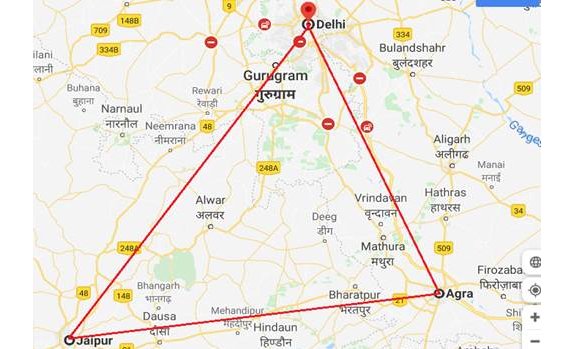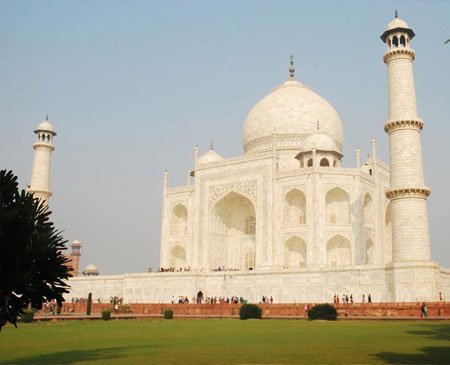- Explore the historic layers of the Old and New Delhi with its UNESCO world heritage sites.
- A heritage walk along with rickshaw ride through the fabled markets of “Chandni Chowk”
- Experience a journey on Indian Railways.
- Visit to “Taj Mahal” – the universally admired masterpiece of the world’s heritage.
- Explore the deserted city of Fatehpur Sikri.
- A cooking demonstration followed by a meal with a local family
- Explore the bustling bazaars of the Pink City of Jaipur.

Day 1: Arrive Delhi
India’s largest city, Delhi, has been one of the country’s commercial and economic hubs for centuries and, as a result, is incredibly rich in culture and history. Made up of the ancient walled city of Old Delhi and the more modern sector, New Delhi, the city encompasses a staggering array of beautiful architecture, notable monuments and age-old temples, including three UNESCO World Heritage Sites – the Red Fort, Qutab Minar and Humayun’s Tomb. Other key attractions include the 17th century Chandni Chowk marketplace – still one of the cities most popular retail centres today, particularly for jewellery and traditional Indian saris; and the Jama Masjid, India’s largest mosque.
On arrival in Delhi: Having cleared immigration, collected your luggage and passed through customs, please make your way towards the exit of the terminal building where you will see a bank of people waiting for you. Amongst them will be Trail Blazer Tours Representative who will be waiting to greet you with a paging board with your name on.
You will be transferred to your hotel and assisted with check in. (Standard check in time at hotel is 1400 hrs).
Day 2: In Delhi
The day is scheduled for a heritage walk of Old Delhi in the morning followed by a tour of New Delhi in the afternoon.
Old Delhi Heritage Walk
Delhi is one of very few places where the ancient and modern co-exist side by side complementing each other perfectly. This Heritage walk helps you explore the Delhi’s rich, culture, heritage, history and cuisine in a fun and exciting way. The tour includes exploring the streets of Old Delhi on foot and on cycle rickshaw. The tour takes you through the narrow lanes and bazaars of Old Delhi where you will get to know about the basic ingredients used in traditional Indian meals.
The tour of New Delhi covers the UNESCO world Heritage sites of Humyauns tomb, Qutab Minar along with a photo stop at India Gate – the war memorial and drive past the Govt. building and the President Palace.
Humayun’s Tomb:
The mausoleum complex of Humayun, India’s second Mughal Emperor, was commissioned by his widow in 1565 and was the first garden tomb to be built in India, taking seven years to complete. Humayun had travelled widely in Persia and Central Asia during his lifetime, and many of the architectural principles he brought back from these journeys were incorporated into the building at his wife’s instructions. With its double domes, decorative inlaid marble and vast garden with pools connected by channels, this 16th Century building set the stage for the style that culminated in the Taj Mahal almost 100 years later.
Qutub Minar
Standing tall at 73-metres, the tower consists of 5 storeys with a flight of spiral stairs leading to its top. The walls are adorned with decorative motifs and Quranic inscriptions. At the foot of the tower lie other monuments of historical significance, such as the Quwwat-ul-Islam Mosque and the Iron Pillar of Delhi. The Amazing race Australia used this site as a pit stop in the second series. Visitors can take advantage of stunning photo opportunities.
Day 3: Delhi- Agra
Home of the world-famous Taj Mahal, Agra is one of India’s prime tourist destinations for specifically this reason, though its attractions also extend to an array of other impressive historical sights. These include the red-hued Agra Fort, the sacred Jama Masjid mosque and Itmad-ud-Daulah’s tomb, with its white marble facade embellished with intricate inlaid designs and semi-precious gems. The Taj, however, is in a league of its own and is a must-see for any visitor to the city. Commissioned by the Mughal emperor Shah Jahan in the 15th century as a memorial to his beloved wife Mumtaz Mahal, it is an architectural masterpiece of exquisite artisanship and perfect proportions.
After breakfast, you will be transferred to railway station to board the train to Agra.
Train Gatimaan Express (daily except on Fridays)
Departs Delhi 0810 Hrs
Arrives Agra 0950 Hrs
Upon arrival at Agra, you will be assisted & transferred and taken directly to Agra Fort for the visit followed by check-in at the hotel. (Standard check in time at the hotel is 1400 Hrs).
Later in the evening, visit Taj Mahal at sunset.
Agra Fort
Known as the Red Fort of Agra, this walled imperial city was founded in 1565 by the Emperor Akbar (1556-1605) and is a well-deserving UNESCO World Heritage site, located just 2.5 kilometres from the famous Taj Mahal. Its palaces, grand mosques and elaborate public hall are crafted from pink-red sandstone and are testament to an era when Indo-Muslim art, strongly marked by influences from Persia, was at its height. Emperor Shah Jahan, who built the Taj Mahal for his deceased wife, was imprisoned by his son Aurangzeb in Agra Fort. He is said to have died in the MusammanBurj, a marble tower he himself built, with one of the most alluring views of the Taj Mahal.
Taj Mahal (Closed on Fridays)
The iconic Taj Mahal is not only an architectural masterpiece, a UNESCO World Heritage Site and one of the new Seven Wonders of the World – it is also the enduring legacy of a royal love story. It was commissioned in the 15th century by the Mughal Emperor Shah Jahan after the death of his third and favourite wife, Mumtaz Mahal, to serve as her final resting place and a symbol of his eternal affection for her.

Combining Islamic, Persian, Ottoman Turkish and Indian design elements, it’s an awe-inspiring structure of elegant domes and white marble, which changes colour along with the light – pink at sunrise, pearly white in the afternoon and silver-gold in the full moon.
Day 4: Agra- Jaipur
Fringed by the rugged Aravali Hills, Jaipur is the capital and largest city in India’s northern state of Rajasthan. This city is famed for being India’s first planned city featuring a multitude of pink terracotta buildings within the walled historic centre, earning it the nickname, ‘The Pink City’. Jaipur falls within the Golden Triangle, a popular tourist circuit, which includes Delhi, Jaipur and Agra, and serves as a gateway to the neighbouring desert cities of Jaisalmer and Jodhpur. This colourful city is a combination of tradition and modernity and offers visitors vibrant bazaars, lavish palaces and ancient temples. The salmon-hued old city is home to the opulent City Palace, encompassing an impressive assortment of palatial structures, sprawling gardens, courtyards and buildings. Do not miss the fairy-tale splendour of the Amber Fort, set against the backdrop of the arid landscape.
After breakfast, leave with the private chauffeur driven vehicle Jaipur (approx. 235 kms/ 06 hours drive) with a stop at Fatehpur Sikri.
Arrive Jaipur in the afternoon and check-in at the hotel.
Fatehpur Sikri
This world heritage site is rated as one of the best-preserved collections of Mughal architecture in India. Surrounded by a six kilometre wall, with the fourth being a lake at the time, a day can be spent exploring the elaborate structures within. Marvel at the impressive Jama Masjid mosque, the detailed palaces built for Emperor Akbar’s wives, the public and private discussion halls and vast ornamental pool; all of which took over 15 years to conceptualise and build.
Day 5: In Jaipur
After breakfast, enjoy Full day sightseeing tour of Jaipur covering Amer Fort, City Palace and the Observatory and a photo stop at Hawa Mahal “Palace of Winds”. Take a shared Jeep ride to reach Amer Fort.
Amer Fort
Amer Fort, officially known as the ‘Amer Palace’, is one of the most famous forts of Rajasthan attracting around 4000 to 5000 visitors a day during peak tourist season. The palace was named after the small town of Amer, where it is situated – only eleven kilometres from Jaipur. Perfectly picturesque, this 16th century hillside residence is well preserved, boasting grand pavilions and mirrored halls that open onto flourishing gardens and courtyards. Although the palace’s main construction started in 1592 by Maharaja Man Singh, it was added to over the years by successive rulers and continued to be occupied by them until Jaipur was built.
Hawa Mahal (Palace of Winds)
One of Jaipur’s most recognised buildings, the Hawa Mahal (Palace of Winds) is known for its iconic façade. Small windows, decorated with intricate latticework create a honeycomb-like appearance. The original intention of the lattice was to allow the royal women to observe everyday life in the street below without being seen. The cooling effect, provided by the breeze passing through the small windows, gave the palace its name. Built in 1799 by Maharaja Sawai Pratap Singh, the unique construction was originally designed to look like the crown of Krishna
Jaipur City Palace
City Palace forms one of the most famous tourist attractions and a major landmark in Jaipur. The beautiful palace was built by Maharaja Sawai Jai Singh during his reign. Among the various forts and palaces of Jaipur, City Palace stands apart, with its outstanding art and architecture.
Jantar Mantar Jaipur
In 1734, the year of its completion, the Jai Singh Observatory was the last outpost of medieval science. From the outside, the eighteen fixed observational instruments look more like playground apparatus than sighting devices, but they were used to measure the position of the sun, stars and planets. Built by Jai Singh, the first Maharaja of Jaipur who founded the city in 1727, the observatory is one of a handful. Jai Singh, fulfilling a lifelong interest in mathematics and astronomy, built observatories in Delhi, Jaipur, Ujjain, Mathura and Benares. The Jaipur observatory is the largest and best preserved of these.
Day 6: Jaipur – Delhi
After breakfast, leave with your private chauffeur driven vehicle to Delhi [Approx. 260 kms / 5-6 hrs]. On arrival, check in at an airport hotel. Rest of day is at leisure.
Day 7: Delhi Departure
At an appropriate time, a Trail Blazer Tours Representative will assist and provide you the necessary transfer to the international airport to board your flight back home.
 Read Newsletter
Read Newsletter
